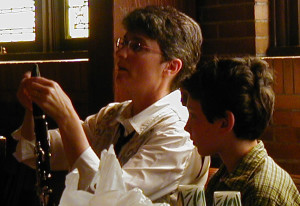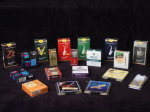Saxophone & Clarinet Lessons 503.888.5796
My Love Affair with Synthetic Reeds

I love playing on synthetic reeds! Two brands I use are Legere and Fibracell. [Update: Fibracell website not responding. You can find Fibracell reeds at any of the online music supply ordering sites.]
Discovering Synthetic Reeds
 I first learned about the modern, new and improved synths when I was doubling on clarinet and alto sax in a pit orchestra for the musical, The Wizard of Oz.
I first learned about the modern, new and improved synths when I was doubling on clarinet and alto sax in a pit orchestra for the musical, The Wizard of Oz.
Good for Doublers
Another woodwind player was using Legere reeds on her clarinet. She claimed that the quick transitions (many times just one or two measures long) from one woodwind to another gave her no time to moisten her cane reed so her clarinet would speak with sweet tone. (Read: so it wouldn’t squeak!)
I’d experienced that problem. And when you are in a pit orchestra, it’s either very hot or very cold. Extreme temps do no good for your reeds or instrument either.
So I ordered a couple online. Reed strengths come in 1/4 increments. I ordered a three (3) and a three and a quarter (3.25). Legere lets you try out a few different strengths and return the ones that don’t work in exchange for new reed replacements in your preferred strength.
This is important because as a rule synthetic reeds are not cheap. They average about $20 per reed.
Advantages of Synthetic Reeds
 On the plus side, every reed plays without fail. There are no duds. You don’t have to scrape and sand synthetic reeds to get them to play. As a matter of fact, most manufacturers of the synthetics tell you NOT to sand or clip your synthetic reeds.
On the plus side, every reed plays without fail. There are no duds. You don’t have to scrape and sand synthetic reeds to get them to play. As a matter of fact, most manufacturers of the synthetics tell you NOT to sand or clip your synthetic reeds.
Because of their sturdy nature, I thought they were indestructible. And compared to cane reeds, they are a lot stronger. You won’t accidentally chip your synthetic reed on your teeth or a music stand. But they can be destroyed. I’ll not forget the day I was teaching saxophone students in a middle school and one of the students showed me her Legere reed with teeth marks!
Another advantage of the Legere and Fibracell reeds is that they last a long time. I’m playing on reeds that I first got over a year ago. The tone is still top notch. At some point though, the synthetic materials do get “get tired” sooner. What I mean by that is they won’t last for a long playing session. I suppose if you had three or four, you could switch them out over the course of a two- or three-hour gig.
Bonus: Being synthetic, they can easily be disinfected and reused by others. Like letting students play on them before investing $20 for their own.
Helping The Teacher Help The Student
Middle Schoolers potential destructive tendencies aside, Legere and Fibracell reeds are great for beginning woodwind players. I will often start a brand new clarinet or saxophone student on a #2 strength cane reed. The light strength almost guarantees its playability. The stronger the reed, the more resistance it provides when you blow into the mouthpiece. This can be challenging for a beginner. The light reed strength ameliorates such early problems.
But once a student has got a basic firm embouchure down, I recommend moving them to a 2.5 synthetic reed. They will not run into any problems with the playability of this reed. Any problems they do encounter can now be identified as operator error. It is much easier for both the teacher and the student to correct user errors.
 User errors are things like incorrect embouchure (mouth interface with the instrument), finger position, and posture. By eliminating the potential problems caused by an unplayable cane reed, other issues can be corrected right away.
User errors are things like incorrect embouchure (mouth interface with the instrument), finger position, and posture. By eliminating the potential problems caused by an unplayable cane reed, other issues can be corrected right away.
New Synthetic Reed On The Market
In the last few weeks, I learned about a new synthetic reed on the market; Bravo Premium Synthetic Reeds. They are distributed by ProTec, a manufacturer of protective instrument cases for professional musicians.
This brand of synth stands out from the crowd on price. You can get a box of five Bravo reeds for $30. Compared to cane reeds, that’s about double. (At the website of Woodwind/Brasswind, a box of ten Vandoren cane reeds is $28, ten Rico reeds go for $25.) But compared to other synthetics, that’s about 70% discounted!
I intend to try them out soon. In a future post, I will compare the various synths that I’ve played over the years and why which ones are keepers.






You promised a review of the Bravo synthetic reeds. I’m in a volunteer civic orchestra and living on a tight budget, so I’d really like to get your input before I invest in them.
Hi Ron!
Sorry for the delay. In short, neither me nor my students who tried them out liked them at all.
They played fuzzy. Not the sound we are going for!
However, I stand by and really enjoy both Legere reeds and Fibracell reeds. Legere is a smoother sound than Fibracell. Fibracell has a bit of an edge. I tend to use Fibracell in jazz settings and Legere in classical settings.
I hope this helps.